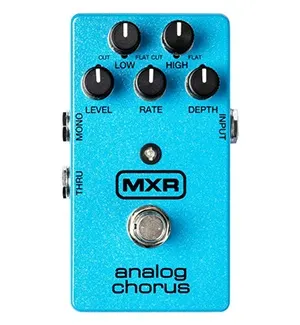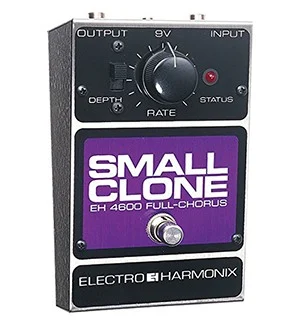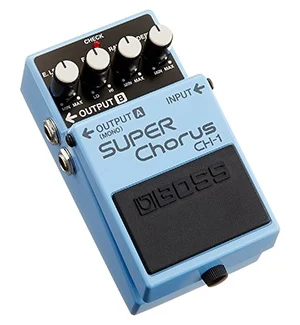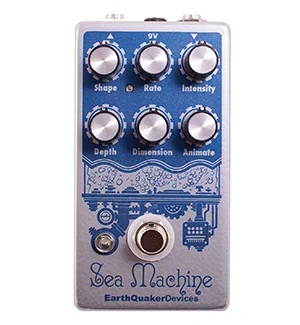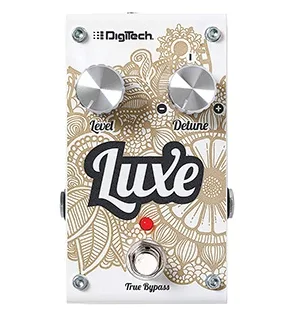The best chorus pedal gives you direct access to the classic effect used by all of the great guitarists to achieve that thick and dreamy tone. It’s the difference between a plain and boring tone and one with character that captures the inquisitive ears and mind of the crowd. There’s no context in which the chorus effect won’t enhance the level of your performance…

Sometimes, we need a thicker, dreamier sound to accentuate specific parts of songs. Coincidentally a very common part of a song to use the chorus effect on is during the chorus itself. But many guitar and synthesizer players will use the effect for the full duration of a song.
By splitting off the original signal and delaying it variably generally from 20 milliseconds up to 50 ms, the listener starts to hear slight alterations in timbre, pitch, and timing just like they hear when a group of instrumentalists attempt to play the same melody in unison. Take this enhanced sound and make it stereo and you’ll have an even bigger impact.
Your tone can combine with the effect to be a very subtle change that does more subconsciously than overtly, or you can combine it with a delay and washed out reverb to create the most dream-like soundscape, sending your audience into another world.
I’ll go as far as to say that there’s likely not a rock or pop album that’s come out in the past 40 years that hasn’t featured the chorus effect at least once, and most likely heavily throughout the whole album.
It’s a staple these days. If it’s not chosen by the band or producer from the outset, the mixer will hear a good chance to add it in and go for it.
Need more information in order to better understand your needs? We have got you covered! Visit our FAQs section.
INCLUDED IN THIS GUIDE:
| MXR M234 ANALOG CHORUS | Best Bang for the Buck | Buy on Amazon |
| TC ELECTRONIC CORONA | Best of the Best | Buy on Amazon |
| ELECTRO-HARMONIX SMALL CLONE | Best Budget Pick | Buy on Amazon |
| BOSS CH-1 STEREO SUPER CHORUS | Best for a Neutral Classic Sound | Buy on Amazon |
| EARTHQUAKER DEVICES SEA MACHINE | Most Versatile on the List | Buy on Amazon |
| DIGITECH LUXE ANTI-CHORUS POLYPHONIC DETUNER | Best for Detuning | Buy on Amazon |
The Best Chorus Pedals
Now that we know what features are important and how to use chorus pedals properly, it’s time to peruse the market and see what’s out there for our hard-earned money. Our overview below represents the best choices available today. They aren’t presented in any special order, although we do point out which is our favorite pick.
We have two more “best in class” picks in the comparison table at the top of the page, but we also recommend that you take the time to consider each option below since your preferences may differ slightly from ours. All in all though, if a pedal made this list, it met and exceeded our expectations.
MXR M234 ANALOG CHORUS
If you’re looking to create lush liquid soundscapes without spending too much but without going too cheap, then our “Best Bang for the Buck” pick will be up your alley. The MXR M234 Analog Chorus is one of the most popular chorus pedals thanks to its sweet spot pricing and high quality effect with plenty of customization options for you to dial in the perfect sound.
To roll through the features real quick, notice there’s a mono output for your wet effect and a thru output so you can route off a dry version of your signal. It’s basically a full bypass. You also get your typical Level, Rate, and Depth knobs, in addition to two EQ knobs. These don’t change your signal itself but just direct the chorus effect to ignore certain frequencies. You’re essentially equalizing the effect itself.
You simply can’t go wrong with this option. Many players will drop the level entirely and always play through it for the sweet saturation the analog circuitry brings. The chorus itself go from a subtle thickening to a full on angelic choir, and everything in between thanks to the EQ knobs. You’re looking at one of the all time bests here. Consider it!
Specs:
- Item Weight: 0.71 pounds
- Signal Format: Analog
- Voltage: 9 V
Pros:
- Lots of control with two-band EQ
- Sounds fantastic in a clean tube amp
Cons:
- Lacks true bypass
TC ELECTRONIC CORONA
Our top choice for best chorus pedal, period, goes out to the TC Electronic Corona. Sure, you get their true bypass switch, digital circuitry, and a tone knob, all nice extras that others are missing here and there. But the real appeal is in the core features.
First you’ll notice there’s two inputs and two outputs, because this beast is capable of full stereo. You’ll notice the Depth, Level, and Speed knobs to control the effect, and also a very welcomed Tone knob to EQ the effect as well.
But take a look at the switch at the top. You get three modes, including a classic Chorus, a Tri-Chorus, and TonePrint. The classic offers a rich creamy chorus, especially at lower speeds, or can become an out of this world sound with high depth and speed.
The Tri-Chorus is a triple, stereo chorus that really fills out the stereo field, washing your listeners in the most beautiful, lush atmosphere possible. That’s great for solos or solo performances.
The middle mode on the switch is the TonePrint, where TC Electronic hosts tons of presets created by professional guitarists and bassists. You can download those to the pedal through your computer or even beam it to your pedal from your smartphone through your guitar’s pickup.
The future is here. You’re looking at our top pick. It’s a no brainer for someone looking for one of the most incredible options at a very reasonable price.
Specs:
- Item Weight: 3.65 Pounds
- Signal Format: Analog
- Voltage: 9 V
Pros:
- Great for acoustic guitars
- Wide range of features
- Great build quality
Cons:
- Cannot switch between factory features and TonePrint
ELECTRO-HARMONIX SMALL CLONE
Our “Best Cheap Pick” goes out to the same pedal that Kurt Cobain loved and popularized, the Electro-Harmonix Small Clone. You’ve heard it on a ton of records and not realized it. This, the EH 4600 Full-Chorus is a classic with far more possibilities than appear on the surface.
It’s as simple to use as they come. You turn it on by clicking the true bypass switch and the red LED indicator lets you know you’re ready.
From there you have two choices. You can turn the rate knob to affect the speed of the effect, and choose whether you want a shallower (top) or deeper (bottom) intensity using the depth switch. And that’s all you need here to go from a very clear and rich extra dimension to your tone to some of the deepest, fastest warbles you’ll ever hear, or anything in between.
What I’d like to see added is a Tone knob, but it’s not a necessity and I’d rather not see this unbelievable price go any higher. EHX has made it possible for instrumentalists on a budget to get access to a top-tier effect by dropping out extra features and sticking to the core values. Not only is this one of the best in general, but you’re not going to find a better option at this price.
Specs:
- Item Weight: 1 pound
- Signal Format: Analog
- Voltage: 9 V
Pros:
- Offers quality sound
- Provides thickness to the tone
Cons:
- Not very sturdy
BOSS CH-1 STEREO SUPER CHORUS
Possibly the best-selling chorus pedal of all time, the Boss CH-1 Stereo Super Chorus is a stellar choice for the player who wants ridiculously long-term reliability and an effect they can trust to be more than good enough.
What I like about Boss is their giant switches and the tank of a chassis they always use. You’d have to try to destroy them and you’d still likely fail.
The four knobs are for your Effect Level, EQ, Rate, and Depth settings. You’ll also notice two outputs, where you can use one for mono or both for lush stereo breadth. As expected, you can go from a subtle thickness and definition added to your tone or dial it up for full dizzying “super chorus.”
While several of their older models of chorus have been discontinued, this one keeps on trucking due to being a fan favorite. Whether you want a gentle motion added or a huge rotating Leslie-like atmosphere, you can get it here.
Specs:
- Item Weight: 1.25 pounds
- Signal Format: Analog
- Voltage: 9 V
Pros:
- Ability to output stereo
- Useable with bass guitar and synths
Cons:
- Cannot save presets
EARTHQUAKER DEVICES SEA MACHINE
You’re not going to find a chorus stompbox with more options and more possibilities for customizing your sound, than the EarthQuaker Devices Sea Machine.
It’s called the Sea Machine for two reasons: you can create the sound of gentle waves rolling up on the shore or huge sea-sick tsunamis crashing against the tide and there’s as many options on this pedal as there are fish in the sea. From subtle and shimmering to warbly pitch-shifted detuning, you can do it all.
This handmade in the USA option features a transparent buffer so that your dry signal passes through the completely analog circuit unaltered and clear, while the wet signal goes through the magic. Let me tell you about the knobs, because this one is a bit different. You have your typical Rate knob to set the LFO speed, Intensity to modulate the delay time, and Depth to control the mix volume this time.
The interesting knobs are the Shape that lets you move from a softer sounding triangle to the hard edged square wave, Dimension that gives you a slight slap-back and reverb, and Animate that lets you stick to a traditional chorus or pitch-bend to create some wild and moving atmosphere.
I consider this one of the best, if not the best, but it’s not for everyone. Lots of players don’t want all of these choices, but for those that do, you can’t beat it.
Specs:
- Item Weight: 0.86 pounds
- Signal Format: Analog
- Voltage: 9 V
Pros:
- Offers retro tone and flexible
- Great price point for its performance
Cons:
- Not very intuitive to use
DIGITECH LUXE ANTI-CHORUS POLYPHONIC DETUNER
If you’re looking for something fresh and different, called an Anti-Chorus (but still a chorus), then the DigiTech Luxe Anti-Chorus is right up your alley. The operation is simple thanks to the interior, digital algorithm used for pitch shifting. It’s called a detuner but the truth is you can add positive or negative values to the pitch shifting up to -50 and +50 cents. So what does this mean?
The Luxe gives you all of the same thickening and dimensions that you get out of a chorus, but without the warbling associated with it. It does this through the pitch-detuning. And that’s all you’ll tweak alongside the Level knob that lets you set the wet to dry ratio.
Lot’s of players like to leave their chorus pedals “always on” at a very low level for that thickening and character but don’t want the wobbling, and that’s what you get here but you can push the character harder.
You can make clean guitar really shimmer by adding some positive detune to it, or really thicken up distorted guitar with a negative value. Or heck, go positive and let the harmonics really pop out. A lot can happen with such a simple operation. If you like the thickness of a chorus but don’t want the warbling, then you’ve found the right choice with the Luxe anti-chorus pedal.
Specs:
- Item Weight: 1 pound
- Signal Format: Analog
- Voltage: 9 V
Pros:
- Excellent build quality
- Easy to use
Cons:
- Works at best when used subtly
FAQs
In this section, let’s look at what this must-have effect does in detail, how to use it, and what to look for when choosing a chorus pedal. By the time we zip through all that, you’ll be equipped to make the choice about which you will prefer and can buy with confidence.
What is the Chorus Effect?
The chorus effect takes an original sound and duplicates it several times, adding minor changes before playing all versions of the sound back in unison. This is achieved in various ways, through slight pitch-shifting, time delays, and low frequency oscillation.
The result is a shimmering version of the original sound due to the fast ‘acoustic beating,’ which is a periodic variance of the volume of the combined sound sources related to the differences in their frequencies.
The effect can be created in stereo in the same fashion by offsetting the delay, phase, and pitch shifting in the left and right channels. The result is a very rich, dreamy, and thick tone that adds a pleasant ambience to an instrument or soundscape.
When combined with the flanger, delay, and reverb effects, an out of this world experience can be created that is otherwise never experienced naturally.
What to Look for in the Best Chorus Pedal?
Like flangers, the components used in chorus stomp boxes haven’t experienced the decline in price that other more common pedals have seen. That means that if you cheap out too much, you’ll get fairly poor results. You need to spend enough to get over the hump of low quality options.
Another thing to consider is that vintage options here sound exactly that. They will sound like very old school, low fidelity versions of what you want. I highly suggest you choose a modern option to not only get the highest quality version of the effect but also to get a higher range of options.
I usually tell people to look at all of the reviews on forums, make sure the chassis is built like a tank since you’re stepping on it frequently, look for a true bypass where possible, etc. But really the world of flangers has boiled down to a handful of reputable and trustworthy options that we’ve listed below.
If you want to save the time, any of the choices below will make you happy, but make sure you read and check out the differences between them that may better suit your preferences and rig.
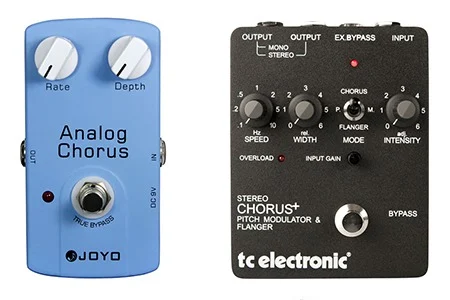
How to Use a Chorus Pedal
Chorus is a confusing effect, not only in regards to how to use in properly but also in terms of where you should put it in the signal path. Let’s explain where to place it in the pedal chain first.
Where to Place it in the Signal Chain
The order of your pedals is defined by nature and logic. Some effects need to come before others to work properly while others follow the sequence we hear naturally out in the world. It goes like this:
- Dynamics, Filters, & Pitch Shifters
- Boost & Distortion
- Modulation
- Time
Chorus is a type of modulation effect. The duplicated signal’s delay and pitch is modulated by a low frequency oscillator (LFO). You don’t want to do any of this until you’ve established your base waveform shape and tone, so naturally it’s going to come after pedals like a compressor, equalizer, and distortion.
But it should come before reverb and delay (time-based effects) like always happens in nature, like sound bouncing around a room.
Understanding the Knob Settings
In general, you will find four knobs: E. Level, Rate, Depth, and Tone. E. Level is an abbreviation for Effect Level, which is the same way of saying Mix level. This sets the dry/wet ratio so you can decide how much you want to hear the effect in respect to the original signal, both of which can come through.
Rate defines the speed of the LFO so the acoustic beating is faster or slower. Depth is basically an intensity knob to increase how noticeable the effect is in terms of the timing of the delay and distance of the pitch shifting.
And finally you have the Tone knob everyone includes on every pedal that’s a shelf EQ you can use to make your frequency response brighter.
Unlike other pedals where manufacturers come up with their own labels or add knobs with different functionality, all of these are generally the same with the same four knobs.
